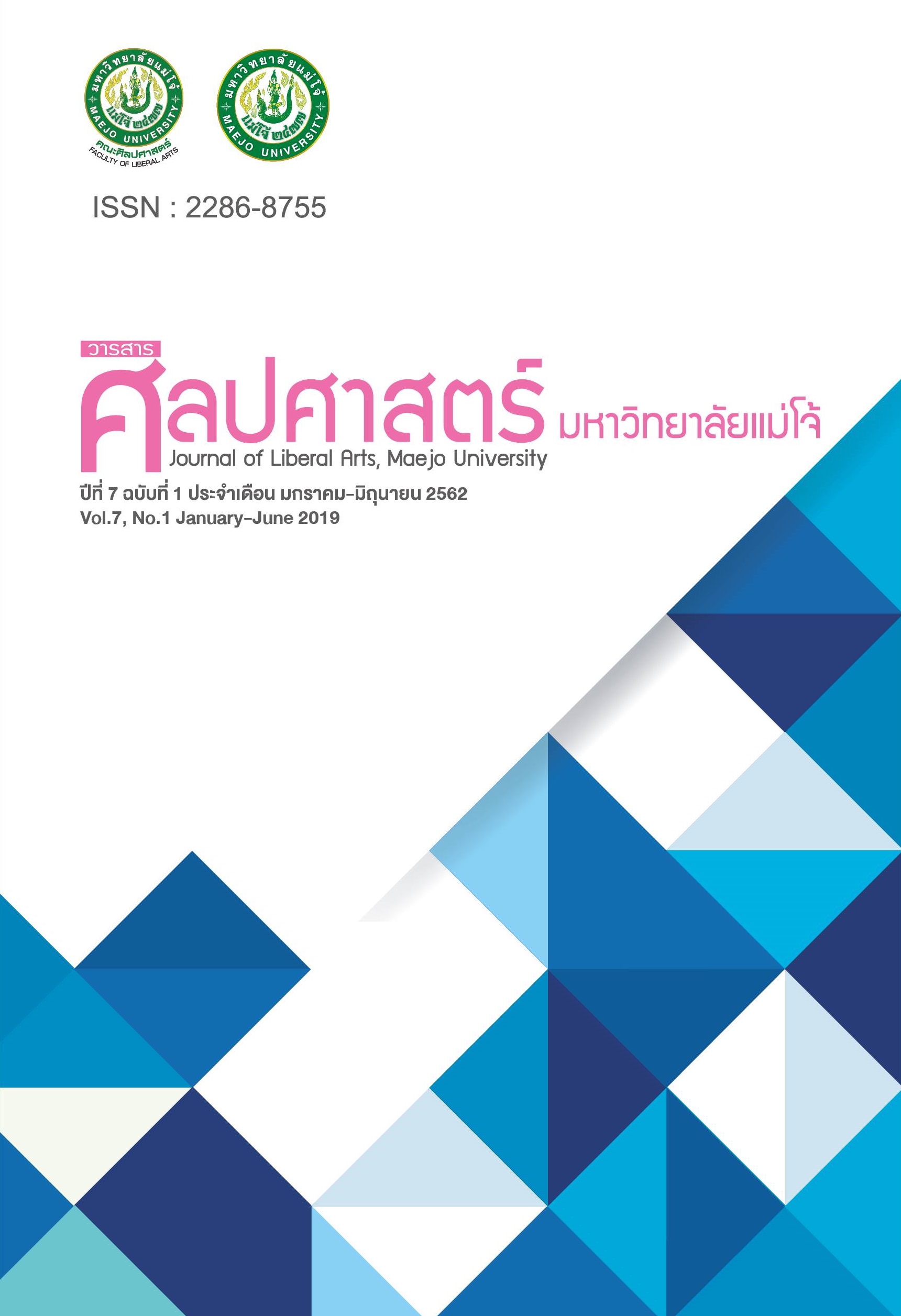กลวิธีในการสื่อสารภาษาอังกฤษของนักศึกษาคณะวิศวกรรมศาสตร์ที่เรียนสาขาวิชาและหลักสูตรการเรียนต่างกัน Strategies in English Oral Communication Employed
Main Article Content
บทคัดย่อ
กลวิธีการสื่อสารภาษาอังกฤษ หมายถึงวิธีการหรือพฤติกรรมที่ผู้เรียนใช้เมื่อเผชิญกับปัญหาในการสื่อสาร ซึ่งแต่ละคนย่อมมีกลวิธีเฉพาะของตนในการสื่อสารภาษาอังกฤษ การวิจัยครั้งนี้มีวัตถุประสงค์เพื่อศึกษาการใช้กลวิธีการสื่อสารภาษาอังกฤษของนักศึกษาไทยที่เรียนทางด้านวิศวกรรม โดยแบ่งตามการใช้กลวิธีการสื่อสารของนักศึกษาในด้านวิศวกรรมที่มีสาขาวิชาเอกและหลักสูตรการเรียนที่แตกต่างกัน กลุ่มตัวอย่างคือนักศึกษาชั้นปีที่ 1 จำนวน 189 คน โดยจำแนกออกเป็นสาขาวิศวกรรมโยธา 57 คน, สาขาวิศวกรรมเครื่องกล 62 คน, และสาขาวิศวกรรมไฟฟ้า 70 คน ซึ่งใช้การสุ่มแบบแบ่งชั้นและการสุ่มอย่างง่าย ตามตารางสำเร็จรูปของ Krejcie and Morgan (1970) เครื่องมือที่ใช้ในการเก็บรวบรวมข้อมูลคือแบบสอบถามการใช้กลวิธีการสื่อสาร ซึ่งผู้วิจัยได้ประยุกต์มาจาก Oral Communication Strategy Inventory ของ Nakatani (2006) สถิติที่ใช้ในการวิเคราะห์ข้อมูลได้แก่ การแจกแจงความถี่, ค่าเฉลี่ย, ส่วนเบี่ยงเบนมาตรฐาน, การวิเคราะห์ความแปรปรวนทางเดียว, และการทดสอบค่าที ผลการวิจัยแสดงให้เห็นว่านักศึกษาไทยที่เรียนทางด้านวิศวกรรมใช้กลวิธีการสื่อสารภาษาอังกฤษโดยภาพรวมอยู่ในระดับปานกลาง กลวิธีที่ใช้มากที่สุดคือกลวิธีการสื่อสารความหมายโดยไม่ใช้ถ้อยคำในขณะพูด ส่วนกลวิธีที่ใช้น้อยที่สุดคือกลวิธีที่เน้นความถูกต้องในการใช้ภาษา เมื่อพิจารณาในด้านสาขาวิชาเอกนั้นพบว่านักศึกษาทั้ง 3 สาขาวิชาในด้านวิศวกรรมมีการใช้กลวิธีการสื่อสารภาษาอังกฤษที่ไม่แตกต่างกัน ในขณะที่นักศึกษาด้านวิศวกรรมที่เรียนในหลักสูตรปกติและหลักสูตรเทียบโอนมีการใช้กลวิธีการสื่อสารที่แตกต่างกันใน 2 ด้าน ได้แก่ กลวิธีด้านสังคมและอารมณ์ และกลวิธีด้านความคล่องแคล่วในการใช้ภาษาเพื่อการสื่อสาร
Article Details
เอกสารอ้างอิง
Allen, D., Freeland, T., Neuwirth, M., Hennings, J &Schauer, L (2008). Creatively speaking: Some strategies for the presentation and delivery of oral presentations. Speaking of Teaching,18(1), 1-7.
Beamer, L. & Varner, I. (2008). Intercultural communication in the global workplace. Boston: McGraw-Hill Irwin.
Bialystok, E. (1990). Communication Strategies: A Psychological Analysis of Second Language Use. Oxford, UK: Basil Blackwell.
Canale, M. &Swaine, M. (1980). Theoretical bases of communicative approaches to second language teaching and testing. Applied Linguistics. 1, 1-47.
Chen, Z.J. (2016) Grammar learning strategies applied to ESP teaching. Theory and Practice in Language Studies,6(3), 617-621.
Chuanchaisit, S.&Prapphal, K. (2009). A study of English communication strategies of Thai university students. MANUSYA: Journal of Humanities, 17, 100-126.
Dornyei, Z. (1995). On the teachability of communication strategies.TESOL Quarterly, 29(1), 55-85.
Faersh, C.& Kasper, G. (1983). Plans and strategies in foreign language communication. In C. Faerch, & G. Kasper (Eds.), Strategies in interlanguage communication (pp.20-60). New York, USA: Longman.
Hyland, F. (2004). Learning autonomously: Contextualizing out-of-class English language learning. Language Awareness, 13(3), 180-202.
Kanoksilapatham, B. (2010). Examining English pronunciation competence of Thai teachers: Word stress assignment. In G. Papanikos& Nicholas C. J. Pappas (Eds.), Horizons in Education (pp. 467-480). Athens: Athens Institute for Education and Research (ATINER).
Krejcie, R.V. & Morgan, D.W. (1970). Determining sample size for research activities. Educational and psychological measurement, 30, 607-610.
Labarca, A. &Khanji, R. (1986). On communication strategies: Focus on interaction. Studies in Second Language Acquisition, 8, 68-79.
Lyster, R. &Ranta, L (1997). Corrective feedback and learner uptake: Negotiation of form in communicative classrooms. Studies in Second Language Acquisition, 19 (1), 37–66.
Metcalfe, J. and Noom-Ura, S. (2013). Communication Strategy Use of High and Low Proficiency Learners of English at a Thai University. LEARN, 6(1).
Mirzaei, A. &Heidari, N. (2012). Exploring the use of oral communication strategies by Non-fluent L2 speakers. The Journal of Asia TEFL,9(3), 131-156.
Nakatani, Y. (2006). Developing an oral communication strategy inventory. The Modern Language Journal, 90(2), 151-168.
Noom-Ura, S. (2013). English-Teaching Problems in Thailand and Thai Teachers' Professional Development Needs. English Language Teaching, 6(11), 139-147.
Nunan, D. & Richards, J.C. (2015). Language learning beyond classroom. New York: Routlege Press.
O'Malley, J. &Chamot, A. (1990). Learning strategies in second language acquisition. Cambridge: Cambridge University Press.
Oxford, R.L. (2001). “Language learning strategies” in R. Carter & D. Nunan. (Eds.). The Cambridge Guide to Teaching English to Speakers of Other Languages (pp.166-172). Cambridge University Press.
Oxford, R. & Burry-Stock, J. (1995). Assessing the use of language learning strategies worldwide with the ESL/EFL version of SILL. System, 23, 1-23.
Saengpakdeejit, R. (2016). Strategies of Thai undergraduates for dealing with oral communication problems. Journal of Liberal Arts, Prince of Songkla University, Hat Yai, 8(2), 78-101.
Somsai, S.&Intaraprasert, C. (2011). Strategies for coping with face-to-face oral communication problems employed by Thai university students majoring in English. GEMA Online Journal of Language Studies, 11(3), 83-96.
Sonkoontod, K. (2011). Technical vocabulary learning strategies employed by engineering at Udon Thani Rajabhat University. (Master Thesis). UdonThaniRajabhat University.
Sutthinaraphan, K. &Wasanasomsithi, P. (2017). A Study of English communication strategy use of undergraduate students majoring in science. The New English Teacher, 11(2), 98-113.
Teng, H.C. (2011). Communication strategy use of EFL college students. In A. Stewart (Ed.), JALT2010 Conference Proceedings. Tokyo: JALT.
Wong, J. K. (2004) Are the learning styles of Asian internationals culturally or contextually? International Education Journal, 4(4), 154-166.
Wongsothorn, A. (2000). ‘Thailand’. In Ho WahKam& R. L. Wong (Eds.), Language policies and language education: The impact in East Asian countries in the next decade, (pp. 229-341). Singapore: Times Academic Press.
Wongtimarat, S., Prachanant, N., &Piyanukul, S. (2016). English speaking strategies employed by English major university students. Journal of Research and Development, Buriram Rajabhat University,11(2), 75-80.

